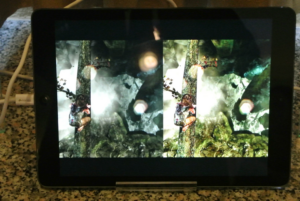We have just succeeded in wrapping our heads around the fact that quantum dot enhancement can signficantly increase the color gamut and color saturation of LCDs with little – and eventually no – increase in system cost.

Now, with its “Iris” mobile display co-processor, Pixelworks is giving us another example of improved display performance with, in this case, reduced system cost.
In the Pixelworks suite at CES, Graham Loveridge (Senior Vice President of Strategic Marketing and Business Development), said Iris is the world’s first mobile display co-processor. Many of Iris’s functions have been performed by television video processing chips and cores for years. But incorporating those functions and others in a chip that takes up sufficiently little space and consumes sufficiently little power for a mobile device is new.
Pixelworks calls the display performance that results from Iris processing “True Clarity.”
One of the more obvious things Iris does is up-convert mobile-display video from 15 or 30 frames per second (fps) to 60 fps. In side-by-side demonstrations in the suite, this provided motion images with far less judder, much smoother scrolling, and motion that had much less blur. This shouldn’t be a surprise since we’ve seen the same evolution in large-screen television, and Iris uses motion estimation and motion compensation (MEMC) algorithms to do its work, which is also used for TV. Loveridge said that Iris is unique in that it does MEMC without producing a halo around moving images.
Side-by-side demo from Pixelworks Suite at CES (Source: Ken Werner)
Pixelworks also claims enhanced colors and wider gamut through the use of a 3D look-up table, better contrast, better high-ambient visibility, and custom color tuning. The color tuning, Loveridge said, can be used to make sure that all displays in a production run look the same. But more than that, the OEM can buy displays from different manufacturers and tune them so they all look the same.
What is surprising is that all of this can be done with a power reduction of roughly 25%. Some of the saving comes from the Iris chip off-loading some functions from the GPU and CPU, and performing them more efficiently.
Because the Iris chip permits savings elsewhere in the display electronics, it can save $6 on panel cost, said Loveridge. The power savings permit a smaller battery, which can save another $2. Depending on order size, chips can be had for less than $6. So, said Loveridge, “if a manufacturer is savvy he can improve system performance and simultaneously lower cost”.
TV-quality LCD cells are increasingly common in mobile devices. With the addition of TV-quality video processing, it will be even more appealing for viewers to do more of their entertainment viewing on mobile devices. – Ken Werner

